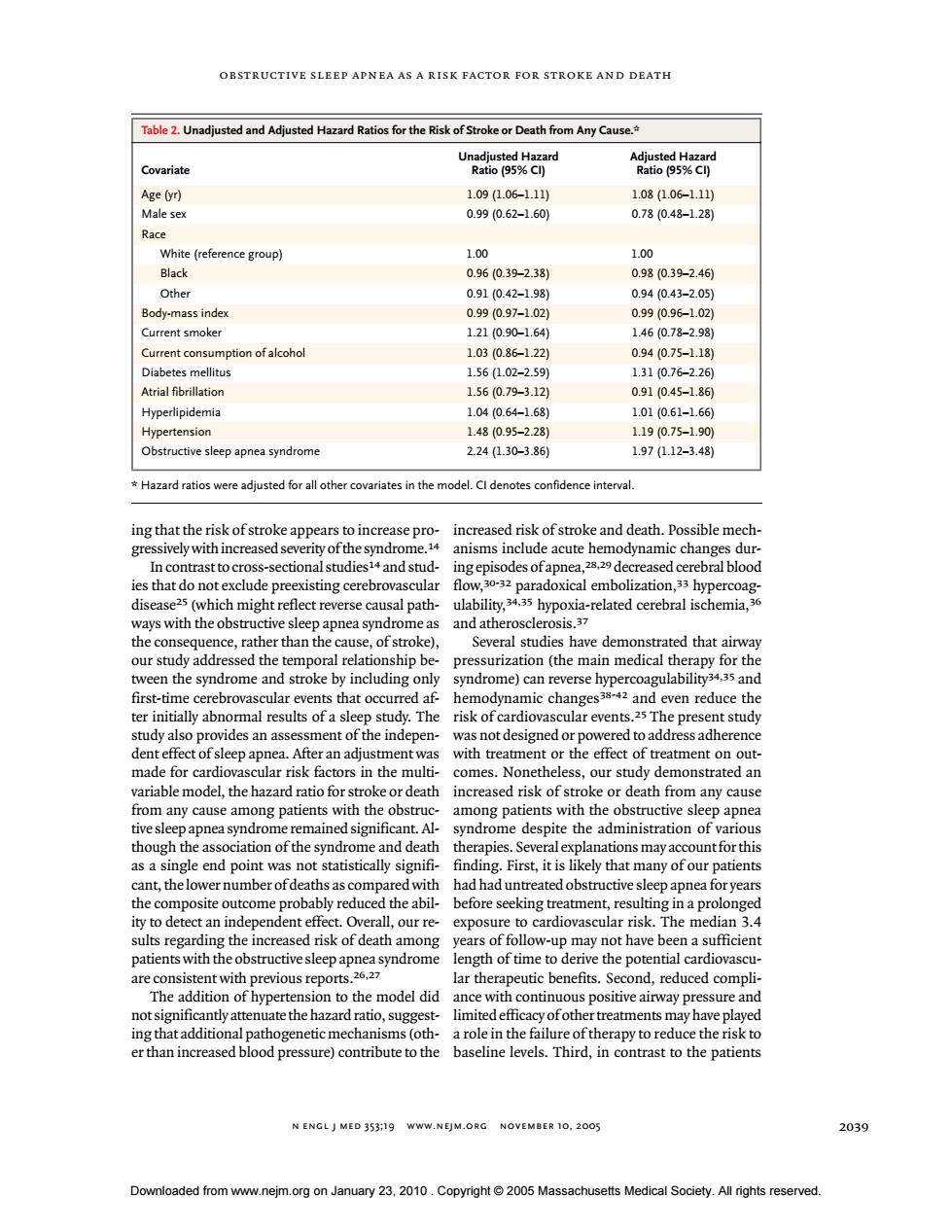正在加载图片...

OBSTRUCTIVE SLEEP APNEA AS A RISK FACTOR FOR STROKE AND DEATH Table 2.Unadiusted and Adiusted Hazard Ratios for the Risk of Stroke or Death from Any Cause* Covariate ath Ratio 9%cn Age 109106111 108106111 0.990.62-1.60 0.7810.48-1.28 Race White (reference group) 100 1.00 Black 0.960.39-2.38) 0.981039-2.46 Other 0.910.42-1.98) 0.940.43-2.05 Body-mass inde 0.990.971.02 0.990.96-1.02☑ Current smoke 121(0.90-1.64 29 rent con ption of alcohol 。9 156070312 0104c16 104064168 1011061166 dypertension 14810.95-228】 1191075-1.90 Obstructive sleep apnea syndrome 2.241.30-3.86 1.971.12-3.483 Hazard ratios were adiusted for all oth ates in the model.Cl denotes confidenc ing that the risk of st ed s appears to ir nd sepro increased risk in es that do not exclude preexisting cerebrovascular flow paradoxical emboliation,hypercoag diseas might reflect reverse causal path related cerebral ischemia. the con rather than the cause ofstroke studies have demonstrated that airway our study addressed the temporal relationship be- pressurization (the main medical therapy for the syndrome)can reverse hypercoagulability lar ever at occ 25 even redu sment of the indeper was not designed or powered to address adherence sk fa tors 1.the ha in the mult comes ess,our study the ith th om any cause tive sleep apnea syndrome.A syndrome despite the administration of various erapies. First,it is the co mnosite out ome p before seekin treatment.resulting in a pro ity to detect an independent effect.Overall,our re- exposure to cardiovascular risk.The median 3.4 s regarding the increased risk of death among of follow up r nothavebd a The addition of hypertension to the model did ance with continuous positive airway pressure and not significantly atte ate the hazard ratio,suggest- limited efficacy of other treatments may have playe ng that additio role in the erapy to re SK N ENGLJ MED 353:19 NOVEMBER 10,200 2039 Dowloaded from www.23.10.Massachusetts Medical Socety.All rights reserved n engl j med 353;19 www.nejm.org november 10, 2005 obstructive sleep apnea as a risk factor for stroke and death 2039 ing that the risk of stroke appears to increase progressively with increased severity of the syndrome.14 In contrast to cross-sectional studies14 and studies that do not exclude preexisting cerebrovascular disease25 (which might reflect reverse causal pathways with the obstructive sleep apnea syndrome as the consequence, rather than the cause, of stroke), our study addressed the temporal relationship between the syndrome and stroke by including only first-time cerebrovascular events that occurred after initially abnormal results of a sleep study. The study also provides an assessment of the independent effect of sleep apnea. After an adjustment was made for cardiovascular risk factors in the multivariable model, the hazard ratio for stroke or death from any cause among patients with the obstructive sleep apnea syndrome remained significant. Although the association of the syndrome and death as a single end point was not statistically significant, the lower number of deaths as compared with the composite outcome probably reduced the ability to detect an independent effect. Overall, our results regarding the increased risk of death among patients with the obstructive sleep apnea syndrome are consistent with previous reports.26,27 The addition of hypertension to the model did not significantly attenuate the hazard ratio, suggesting that additional pathogenetic mechanisms (other than increased blood pressure) contribute to the increased risk of stroke and death. Possible mechanisms include acute hemodynamic changes during episodes of apnea,28,29 decreased cerebral blood flow,30-32 paradoxical embolization,33 hypercoagulability,34,35 hypoxia-related cerebral ischemia,36 and atherosclerosis.37 Several studies have demonstrated that airway pressurization (the main medical therapy for the syndrome) can reverse hypercoagulability34,35 and hemodynamic changes38-42 and even reduce the risk of cardiovascular events.25 The present study was not designed or powered to address adherence with treatment or the effect of treatment on outcomes. Nonetheless, our study demonstrated an increased risk of stroke or death from any cause among patients with the obstructive sleep apnea syndrome despite the administration of various therapies. Several explanations may account for this finding. First, it is likely that many of our patients had had untreated obstructive sleep apnea for years before seeking treatment, resulting in a prolonged exposure to cardiovascular risk. The median 3.4 years of follow-up may not have been a sufficient length of time to derive the potential cardiovascular therapeutic benefits. Second, reduced compliance with continuous positive airway pressure and limited efficacy of other treatments may have played a role in the failure of therapy to reduce the risk to baseline levels. Third, in contrast to the patients * Hazard ratios were adjusted for all other covariates in the model. CI denotes confidence interval. Table 2. Unadjusted and Adjusted Hazard Ratios for the Risk of Stroke or Death from Any Cause.* Covariate Unadjusted Hazard Ratio (95% CI) Adjusted Hazard Ratio (95% CI) Age (yr) 1.09 (1.06–1.11) 1.08 (1.06–1.11) Male sex 0.99 (0.62–1.60) 0.78 (0.48–1.28) Race White (reference group) 1.00 1.00 Black 0.96 (0.39–2.38) 0.98 (0.39–2.46) Other 0.91 (0.42–1.98) 0.94 (0.43–2.05) Body-mass index 0.99 (0.97–1.02) 0.99 (0.96–1.02) Current smoker 1.21 (0.90–1.64) 1.46 (0.78–2.98) Current consumption of alcohol 1.03 (0.86–1.22) 0.94 (0.75–1.18) Diabetes mellitus 1.56 (1.02–2.59) 1.31 (0.76–2.26) Atrial fibrillation 1.56 (0.79–3.12) 0.91 (0.45–1.86) Hyperlipidemia 1.04 (0.64–1.68) 1.01 (0.61–1.66) Hypertension 1.48 (0.95–2.28) 1.19 (0.75–1.90) Obstructive sleep apnea syndrome 2.24 (1.30–3.86) 1.97 (1.12–3.48) Downloaded from www.nejm.org on January 23, 2010 . Copyright © 2005 Massachusetts Medical Society. All rights reserved